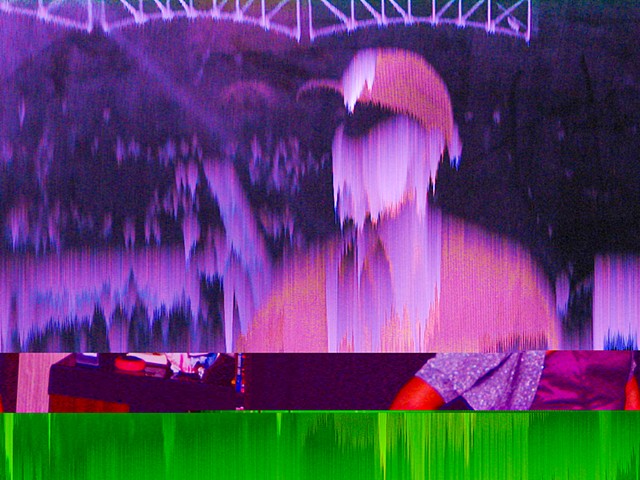Stephan Apicella-Hitchcock/Anibal Pella-Woo
Anibal Pella-Woo
Selected by Stephan Apicella-Hitchcock
Recovered Memory Cards (2017 - Ongoing)
This project began out of necessity.
In 2017, a student asked me if it was possible to recover images that had been accidentally deleted from a memory card. After finding a consumer-grade data recovery program, I put one of my old CF (CompactFlash) memory cards to the test. I was surprised by how far back in time the software was able to travel and recover data. The new picture versions were lower in resolution and sometimes put together like a puzzle, but these new interpretations had attractive qualities and were different from their originals.
Intrigued by what looking at these new images added to my understanding of photography, I began purchasing used, low-capacity compact flash cards from eBay and putting them through the same software. These cards, much like my old one, began yielding surprising results.
First manufactured by the SanDisk corporation in 1994, the CompactFlash card was used widely in early digital cameras. Now, it is an almost obsolete technology, having been superseded by the smaller and faster SD (SecureDigital) card as the storage standard.
Many of these recovered digital photographs were probably seen and shared on the built-in camera screen just moments after being taken, then forgotten. Others ended up on ever refreshing and updating social media streams or obsolete hard drives. Images were deleted, memory cards reformatted, and reused. The development of the smartphone as the family camera took care of the rest. Since 2017, I have been building an archive of both CF cards and the images I was able to recover from them. Influenced by the old practice of picture hunting in second-hand stores and flea markets, I see my process as rescuing images from the great digital waste heap. This is a project with no foreseeable end.
The images that make up this current group were selected from 14,318 images rescued so far in 2023. In editing and selecting them, I have tried to stay away from certain cliches of “amateur photography” while capitalizing on others. They are simply terrific. —Anibal Pella-Woo
Stephan Apicella-Hitchcock on Anibal Pella-Woo
At one point, it would be reasonable to assume that most families had an album or shoebox tucked away somewhere in their house filled with various-sized photographs. They were made with film cameras and commemorated the range of human endeavors. Currently, most images are created on smart devices and rapidly transmitted for sharing; however, between these two periods, people used digital cameras, saved their images to compact flash cards, and then made prints for their collections. Cuban-born American photographer Anibal Pella-Woo has found a practically invisible archive suspended in this transitional period between technologies.
Purchasing used, cheap compact flash [CF] cards on eBay, then using available commercial recovery software, Pella-Woo rescues previously erased picture data. Most of the information that comprises the images is scrambled and irretrievable. Nevertheless, occasionally data can be restored and reconstructed to form the initial photograph. Sometimes the pictures are entirely salvageable, and periodically they are partially corrupted. Either way, these images were deleted from the world yet remained inert on flashcards and potentially recoverable.
Rummage sales and flea markets often sell fragmented collections of abandoned photos, but to characterize Pella-Woo as recovering unwanted pictures would be somewhat inaccurate. These images were presumably desirable but deleted to make way for new photographs. Eventually, as people transitioned from digital cameras with compact flash cards to newer storage technologies (secure digital [SD] cards), some erased their old cards and sold them. They were both blissfully and unfortunately unaware that the only way to safeguard oneself from data retrieval is not by diligently erasing memory cards but by physically obliterating them with a rock. Digital traces of what once was can stubbornly remain behind, latent, and waiting for those with the correct decoder ring.
Until recently, people used the term "latent image" primarily regarding the dominant form of analog photography. Images are secured on photosensitive film during exposure and remain invisible and dormant until processed out and made observable after chemical development. Oddly, with the rise of new technologies in the world of image-making, this phrase seems to have a second life. And it is in this sense, Pella-Woo is not unlike a photographic hunter tracking and capturing numerous invisible and latent moments and then "processing" them by software out of thin air.
Rescued images span a range of subjects; nevertheless, as Pella-Woo gathers more, themes have emerged since people have invariably been making the same types of pictures since the inception of photography: landscapes, portraits, and possessions. Contemporary subcategories would necessitate "items for sale" and "birthday cakes." Of course, there is erotica, as ever, but the majority depict the quotidian details of everyday life and range from sublime to exhaustively mundane.
One might take umbrage with bringing deleted data back to life and see it as a privacy violation. Debatable but negligible compared to the quantity of visual information that one cedes control over in any given day to intersection cameras and ATMs. This project is more akin to loving recycling or processing as with traditional photography. Our technician materializes an image through a series of transactional and software-based steps, and what we glimpse is far more honorific than voyeuristic, more odd and surreal than salacious. Pella-Woo is hot on the trail of the ephemeral, finding minute fragments of digital residue, attending to them, and image by image closing in on an elusive and phantasmagoric picture library lingering in the ether.
